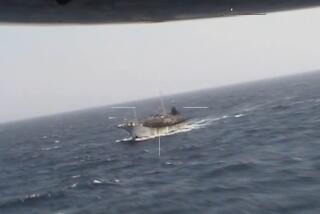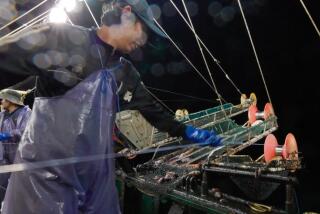Satellites May Be Used to Spot Salmon Poachers : New Agreement Aimed at Fish Rustlers
- Share via
WASHINGTON — The vast waters of the North Pacific cover an area the size of the continental United States, and a Coast Guard patrol plane could fly for hours without detecting one of the rogue fishing vessels said to be illegally catching salmon in international waters.
But on the heels of an elaborate high-seas “sting” operation, which netted a ring of alleged fish rustlers in July, comes a new accord that will give the federal government greater power to control salmon poaching.
Now for the first time, “fish cops” working for the National Oceanic and Atmospheric Administration may soon be keeping track of the exact location of hundreds of foreign vessels by using satellites to monitor their positions.
Satellite Transmitters
After years of touchy negotiations, the U.S. State Department and Taiwan have reached an agreement requiring fishing boats in the North Pacific to carry satellite transmitters. The devices will be monitored by NOAA satellites so that special agents can turn on a computer in Washington and observe the locations of fishing boats, said Steve Springer of NOAA Fisheries Office of Enforcement.
The accords deal with foreign vessels that use “drift nets.” These fine-mesh nets can stretch 40 miles, about the distance between Washington and Baltimore. The nets are used by Taiwan, South Korea and Japan to catch squid at night, but they also trap anything else that swims into them.
Because the nets are indiscriminate killers, and are capable of ensnaring not only squid, but salmon, seals, dolphins and sea birds, environmentalists have called them “curtains of death.”
“You put up a fine-mesh net between here and Baltimore and see how many birds you catch,” said George Herrfurth of NOAA Fisheries Office of International Affairs.
May Be Creeping North
The drift-net fishing boats are supposed to stay below certain northern latitudes where salmon are commonly found. But in recent years, NOAA fisheries agents have suspected that many squid boats are creeping into the far North Pacific waters and using drift nets on salmon.
The illegal salmon catches are then “laundered” through middlemen and sold to foreign or domestic buyers.
The U.S. government considers all salmon that spawn in the rivers of the Pacific Northwest and Alaska to belong to U.S. fishermen, who net the fish on their return to the streams where they were born.
U.S. fishermen and members of Congress have charged that poaching by foreign vessel is depleting salmon stocks, a $1-billion industry.
Fishing ‘Sting’ Operation
The agreement with Taiwan comes days before a deadline stipulated by the Drift Net Act of 1987, and follows the “sting” operation aimed at Taiwanese fish brokers who were allegedly trying to sell illegally netted salmon to NOAA undercover agents in Seattle.
The project culminated in a dramatic, high-seas chase that lasted several weeks, as two fleeing Taiwanese drift-net vessels allegedly in league with the fish dealers in Seattle were pursued across the Pacific Ocean by a Coast Guard cutter.
As important as the use of satellites, the new agreements will allow federal agents to board and inspect foreign vessels in international waters. Boarding boats on the open seas is an intrusion zealously opposed by most captains.
Catch Must Be Recorded
The accords also require that observers record what foreign fishermen pull up in their nets, so for the first time impartial counts can be made of what is hauled up from the deep.
“The accord gives us an unprecedented amount of information on the drift-net fishery,” said Larry Smead, director of the State Department Office of Fisheries Affairs, which conducted the talks along with NOAA and the Coast Guard.
More to Read
Sign up for Essential California
The most important California stories and recommendations in your inbox every morning.
You may occasionally receive promotional content from the Los Angeles Times.













